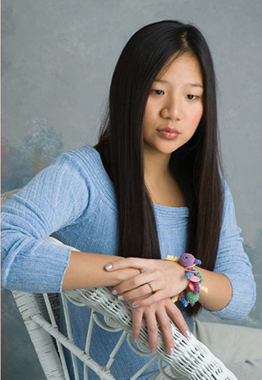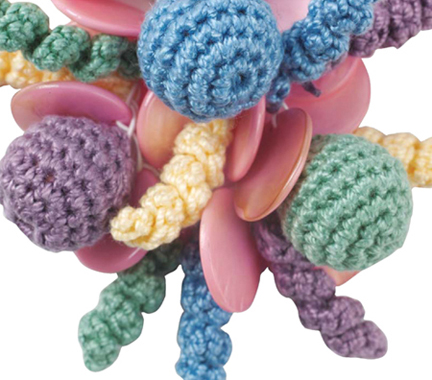Candy-Colored Bracelet

One size fits all
Skill Level — Beginner
This is a fun bracelet to make and to wear. Try crocheting it in other colors or as a necklace for more jewelry options.
Materials:
1 ball (150 yd.) each 4 different colors #3 crochet cotton thread
US steel hook #5 (1.7 mm)
16″ dangles (½″–¾″ each) or can substitute buttons
White elastic cord or clear stretch plastic thread for beading
3 wooden or plastic ¾″ beads
Sewing needle with eye large enough for elastic to go through
Yarn needle
Used in this project: J&P Coats Royale Fashion Crochet Thread, Favorite Findings shelly #1838
Gauge:
3 sc = ¼″
Helpful Hint:
If you are a beginner and have difficulty understanding a pattern, then why not ask for someone's help? It's much better than being frustrated.
INSTRUCTIONS:
Curlique
For sm-med wrist, make 13; for lg-xlg wrist, make 16 (3–4 of each color).
Ch 15, 2 sc in second ch from hook, and 2 sc in each ch across. End off. Tie loose ends tog. Rep with other colors. If you want a shorter curlique, work fewer beg chs.
Ball
Make 3–4 (in different colors).
Ch 2, 8 sc in second ch, sl st to first sc, cont working in rnds, without joining. You'll need to inc some sts toward center of bead. Put bead inside to make sure it fits. After the halfway mark and toward the top, dec some rnds until the hole is closed up. End off.
To Assemble
Lay pieces on a table in the order to be placed on bracelet. Place round shells, balls and curliques onto elastic with needle. Make sl knot and ch 1, * pull up pink shell, ch 1 around it, ch 1; rep from *, alternating shells, balls and curliques until you have enough pieces to fit around wrist. Leave an 8″ tail on each end of elastic. Tie loose ends of elastic tog, and weave in ends.

Words of Encouragement
Do you focus on your problems and wonder why they are not solved? My husband shares this approach in his “Yes You Can” Seminar — we tend to spend 90% of our time on the problem and 10% of our time on the solution. We become far more effective when we reverse that tendency and spend 10% of our time on the problem and 90% on solutions!90% of the things we worry about never happen anyway, so it's better to spend more time coming up with a solution than worrying about the problem itself.